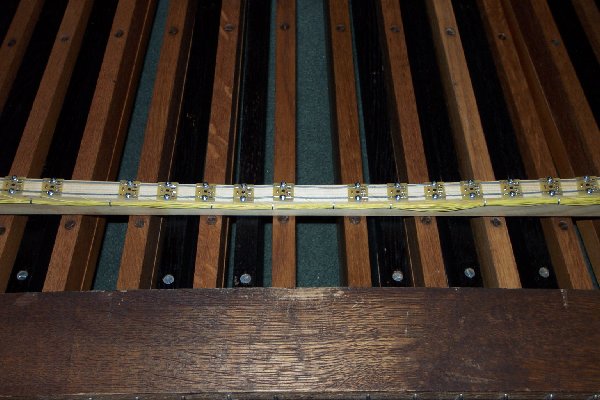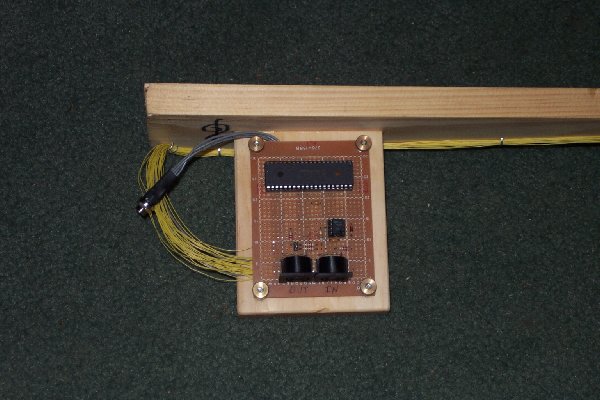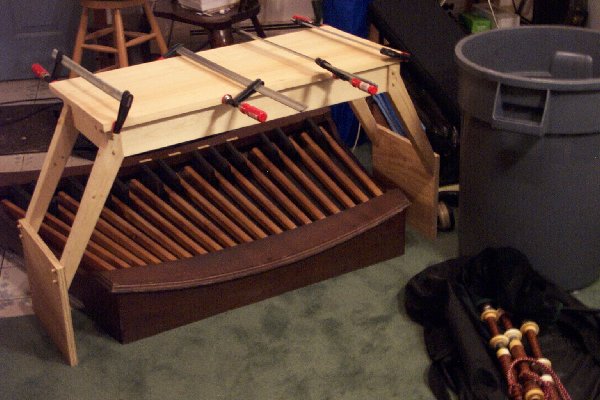I'm trying to work out my organ envy problem by putting together a fake synthesized pipe organ. Obviously the sound is nowhere close to the real thing, and the keyboard is a toy, but it's still better than nothing.
![]()
This is a combination of the cheapest five-octave MIDI keyboard I could find, plus a used real pipe organ pedalboard (that I got from an organ builder in CT for $150), with a shoddy home-made keyboard stand and bench to give the whole mess the proper AGO dimensions, except that the vertical spacing between the keyboard shelves is more than the official dimension to allow for the thickness of the MIDI keyboard's case. So if I ever add the second keyboard it will be higher than it's supposed to be (now done, new photo one of these days). But the relationships between the (lower) keyboard and the pedalboard and the bench are correct, except I made the bench 1" taller than specified since I was afraid it would be uncomfortable otherwise. The whole mess is plugged into a Roland SC-88 synthesizer (the little brick on the left end of the upper keyboard shelf), and a stereo amplifier.

I didn't want to rely on the ancient contacts that came on the pedalboard, especially since I'd like to try building a pedalboard from scratch at some point, which wouldn't have them. So I tore off the contacts and used Hall-effect sensors (i.e. semiconductor magnetic detectors), which ought to be ridiculously reliable. That meant designing a simple PCB layout for the sensor and resistors/cap that go with each, and then screwing 32 of these little 3/4" square PC boards onto the edge of a 1x4 board that I'd cut so the edge followed the arc of the key levers (as they intersect a vertical plane), spaced so that each one is directly under a key lever. Then I drilled 1/4" holes into the bottoms of the key levers and epoxied round magnets (after experimenting to pick the best magnet size) into them directly over the Hall-effect sensors, and experimented more to find a position for the 1x4 board where all 32 sensors worked reliably with a logic probe. The above picture shows the 1x4 before installation, turned upside-down so you can see the sensor PCBs (the magnets in the key levers are obscured by the frame at the bottom of the picture).

The 32 Hall-effect sensors are all wired to a Microchip PIC16F747 microcontroller chip, chosen because it has tons of I/O pins and a USART, and internally-generated reset and a calibrated internal RC clock so the only external part it needs is a bypass cap -- I wish it had data EEPROM though, so I could make the key mapping configurable and there'd be no need to keep the 32 input wires in order. There's a 6N138 optoisolator to do 5 mA current-loop level conversion so the USART works for MIDI, and I wrote a PIC program to poll the keyboard and generate MIDI key-up/key-down events, and also merge in a keyboard data stream from the input connector but that code isn't fully reliable yet (occasionally loses a byte). The wiring is really delicate (it's all #30 wire-wrap wire) but it's stapled out of the way of any moving parts so that's only a problem when the pedalboard is being moved. If I ever start making more of these I'll probably lay out separate PCBs for each block of contiguous key levers, and have a much simpler wiring harness (ribbon cable).

This is just a bench but it came out pretty well considering it's made mostly out of plywood and pieces cut from 2x4s (except for the top which is nice 1x pine, glued up to the proper width, arc cut in the front with a bandsaw, and the edges rounded over with a router). Here it is while the glue was drying halfway through assembly (before the 2x4 footrest went in).